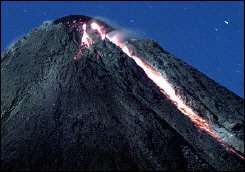In the long run, all that ash can be a good thing

Volcano ash can wreck jet engines, poison freshwater lakes and damage lungs. But it helps fertilize oceans, volcano researchers and marine chemists say.
"The ocean is going to be happier" because of the Iceland eruption, said Ken Johnson, senior scientist with the Monterey Bay Aquarium Research Institute. "Plants will grow more" -- although how much more, he said, is unclear.
About 30 percent of the oceans are what scientists call iron-limited -- rich in many nutrients but missing iron, a crucial trace element for plants.
Once the microscopic marine plants known as phytoplankton run out of iron, they can't grow any further.
Sprinkling the ocean with all that volcanic ash, which is really shards of glass rich in iron and other minerals, releases that limit. With more iron, the phytoplankton start growing. More phytoplankton means more food for animals up the marine food chain.
The phytoplankton also pull carbon dioxide from the atmosphere, using the gas to make energy. Since carbon dioxide is a greenhouse gas, this should help reduce rates of global warming, researchers theorize.
A study published in 2001 noted that the level of carbon dioxide in the atmosphere had been on a constant rise except during two periods when the rate leveled off: from 1963 to 1965, after an eruption of the Mount Agung volcano in Bali, Indonesia, and from 1991 to 1993, after the eruption of Mount Pinatubo on the island of Luzon in the Philippines.
The study, which was published in the journal Geology, showed that ash from Hekla, one of Iceland's most active volcanoes, releases phosphate, iron, silica and manganese into the ocean very quickly when exposed to seawater -- fast enough, the authors said, for plant life to take immediate advantage of the nutrients.
A 2007 study published in Geophysical Research Letters directly tested the effect of ash from volcano eruptions in Costa Rica, Japan and Alaska on samples of phytoplankton grown in the laboratory.
The scientists found that levels of chlorophyll a, a key plant pigment, nearly tripled in their samples -- an indication that the plants were growing much more vigorously than nonfertilized samples.
To show that introducing iron could have a dramatic effect in the open ocean, in 1995 Johnson and coworkers went out to iron-limited waters about 1,000 miles west of the Galapagos Islands and pumped iron into the clear, blue, algae-free water.
When they came back a week later, Johnson said, "It was a pea-green soup ... just a totally different world."
The local fish, mahi mahi, had disappeared. But then Johnson saw some uncommon visitors to the wide open ocean: giant sea turtles, drawn by the algal feast, "just having a field day," Johnson said.
The North Atlantic, where most of the ash from the Eyjafjallajokull volcano is set to land, is not the best place to further test the ocean-fertilization theory, Johnson said, because it isn't as iron-deficient as other ocean regions, though it could benefit from the ash's phosphates.
Moreover, ash spewed out of the volcano was less than one-fiftieth of what was put out by Mount Pinatubo in the early 1990s and was dispersed very widely, said volcano researcher Thorvaldur Thordarson of the University of Edinburgh.
"Farmers directly affected by the fallout are going through hard times at the moment because their fields are all covered in ash," added Thordarson, hours after visiting the site to collect ash a few miles from the base of the volcano. But the nutrient-rich dust could fertilize the farmers' crops as early as this summer, he added.
"In the end," he said, "they might get a better harvest."
(c) 2010, Los Angeles Times.
Distributed by McClatchy-Tribune Information Services.

















